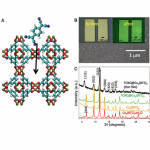 “Tunable electrical conductivity in metal-organic framework thin film devices”, A. A. Talin, A. Centrone, M. E. Foster, V. Stavila, P. M. Haney, R. A. Kinney, V. A. Szalai, F. E. Gabaly, H. P. Yoon, F. Léonard, and M. D. Allendorf, Science 343, 66-69, 2014.
“Tunable electrical conductivity in metal-organic framework thin film devices”, A. A. Talin, A. Centrone, M. E. Foster, V. Stavila, P. M. Haney, R. A. Kinney, V. A. Szalai, F. E. Gabaly, H. P. Yoon, F. Léonard, and M. D. Allendorf, Science 343, 66-69, 2014.
1. Sandia National Laboratories, Livermore, CA 94551, USA.
2. Center for Nanoscale Science and Technology, National Institute of Standards and Technology, Gaithersburg, MD 20899, USA.
3. Maryland Nanocenter, University of Maryland, College Park, MD 20742, USA.
ABSTRACT. We report a strategy for realizing tunable electrical conductivity in metal-organic frameworks (MOFs) in which the nanopores are infiltrated with redox-active, conjugated guest molecules. This approach is demonstrated using thin-film devices of the MOF Cu3(BTC)2 (also known as HKUST-1; BTC, benzene-1,3,5-tricarboxylic acid) infiltrated with the molecule 7,7,8,8-tetracyanoquinododimethane (TCNQ). Tunable, air-stable electrical conductivity over six orders of magnitude is achieved, with values as high as 7 siemens per meter. Spectroscopic data and first-principles modeling suggest that the conductivity arises from TCNQ guest molecules bridging the binuclear copper paddlewheels in the framework, leading to strong electronic coupling between the dimeric Cu subunits. These ohmically conducting porous MOFs could have applications in conformal electronic devices, reconfigurable electronics, and sensors.

